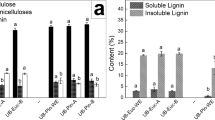Abstract
This research was intended to evaluate the potential of bioethanol production from Jabon wood. Kraft pulping was conducted to achieve pulp with kappa number of 0, 10, 20, 30, 40, and 80. Fully bleached pulp was prepared from pulp with kappa number of 15. The resulted pulps were beaten with PFI mill to achieve the freeness level of 400, 300, 200, and 100 mL CSF. Ethanol was produced through SSF process. Reducing sugars and ethanol concentration were determined by Nelson-Somogyi method and gas chromatography (GC), respectively. Significant increase of reducing sugar was achieved by pulp beating to 100 mL CSF. Pulp with Klason lignin of 12 % produced the highest total and residual reducing sugar (11.5 and 9.4 %, respectively), but with the lowest fermented reducing sugar (2.2 %). Pulp with 0 % Klason lignin resulted in the lowest residual reducing sugar (2.7 %) and the highest fermented reducing sugar (8.4 %). Pulp with Klason lignin of 0.0 and 1.5 % at the freeness level of 100 mL CSF resulted in the highest ethanol yield (16.4 and 14.4 %, respectively) and cellulose conversion (24.2 and 22.1 %, respectively). Above 4.5 % concentration, lignin hampered reducing sugar fermentation. Promising performance of enzymatic hydrolysis was achieved when pulp was at least 50 % delignified and relatively high ethanol yield was gained with at least 94 % lignin removal. In view of delignification and increasing beating intensity of pulp increased sugar and ethanol production, the present results support the possibility of repurposing kraft mills for the production of cellulose-based bioethanol.


Similar content being viewed by others
References
Wistara, N.J., Carolina, A., Pulungan, W.S., Emil, N., Lee, S.H., Kim, N.H.: Effect of tree age and active alkali on kraft pulping of white Jabon. J. Korean Wood Sci. Technol. (2015). doi:10.5658/WOOD.2015.43.5.566
Sapulete, E., Kapisa, N.: Informasi Teknis Tanaman Jabon (Anthocephalus cadamba Miq). Buletin Penelitian Kehutanan. 10(3), 183–195 (1994)
Dawson, L., Boopathy, R.: Cellulosic ethanol production from sugarcane bagasse without enzymatic saccharification. BioResources. 3(2), 452–460 (2008)
Qin, C., Clarke, K., Li, K.: Interactive forces between lignin and cellulase as determined by atomic force microscopy. Biotechnol. Biofuels 7(65), 1–9 (2014)
Sun, Q., Foston, M., Meng, X., Sawada, D., Pingali, S.V., O’Neill, H.M., Li, H., Wyman, C.E., Langan, P., Ragauskas, A.J., Kumar, R.: Effect of lignin content on changes occurring in poplar cellulose ultrastructure during dilute acid pretreatment. Biotechnol. Biofuels 7(150), 1–14 (2014)
Phillips, R.B., Jameel, H., Chang, H.M.: Integration of pulp and paper technology with bioethanol production. Biotechnol. Biofuels 6(13), 1–12 (2013)
Ioelovich, M.: Accessibility and crystallinity of cellulose. BioResources. 4(3), 1168–1177 (2009)
Zuchairah, I.M.: Hidrolisa Enzymatik pada Serat Selulosa. Teknol. Ind. 10(2), 119–128 (2005)
Mishra, M.S., Chandrashekar, B., Chatterjee, T., Singh, K.: Production of bio-ethanol from Jatropha oilseed cakes via dilute acid hydrolysis and fermentation by Saccharomyces cerevisiae. Int. J. Biotechnol. Appl. 3(1), 41–47 (2011)
Lecourt, M., Meyer, V., Sigoillot, J.C., Petit-Conil, M.: Energy reduction of refining by cellulases. Holzforschung (2010). doi:10.1515/HF.2010.066
Wistara, N.J., Sitanggang, V.J., Hermiati, E.: Ethanol production using SSF method from paper-based material exposed to various physical treatments. J. Tek. Ind. Pert. 23(3), 184–189 (2013)
Dence, C.W.: The determination of Lignin. In: Lin, S.Y., Dence, C.W. (eds.) Methods in Lignin Chemistry, pp. 33–62. Springer, Berlin (1992)
Browning, B.L.: Method of Wood Chemistry. Wiley Interscience Publisher, New York (1967)
Wrolstad, R.E., Acree, T.E., Decker, E.A., Penner, M.H., Reid, D.S., Schwartz, S.J., Shoemaker, C.F., Smith, D., Sporns, P. (eds.): Handbook of Food Analytical Chemistry: Water, Proteins, Enzymes, Lipids, and Carbohydrates. Wiley, New York (2005)
Panagiotou, G., Christakopoulus, P., Olsson, L.: Simultaneous saccharification and fermentation of cellulose by Fusarium oxysporum F3-growth characteristics and metabolite profiling. Enzyme Microb. Technol. (2004). doi:10.1016/j.enzmictec.2004.12.029
Erdei, B., Barta, Z., Sipos, B., Reczey, K., Galbe, M., Zacchi, G.: Ethanol production from mixtures of wheat straw and wheat meal. Biotechnol. Biofuels 3(16), 1–9 (2010)
Demirbas, A.: Bioethanol from cellulosic material: a renewable motor fuel from biomass. Energy Sources (2005). doi:10.1080/00908310390266643
Studer, M.H., DeMartini, J.D., Davis, M.S., Sykes, R.W., Davison, B., Keller, M., Tuskam, G.A., Wyman, C.E. 2011. Lignin content in natural Populus variants affects sugar release. PNAS (2011). doi:10.1073/pnas.1009252108
Krishna, S.H., Chowdory, G.V.: Optimization of simultaneous saccharification and fermentation for the production of ethanol from lignocellulosic biomass. J. Agric. Food Chem. 48, 1971–1976 (2000)
Henriksson, M., Henriksson, G., Berglund, L.A., Lindstorm, T.: An environmentally method for enzyme assisted preparation of microfibrillated cellulose (mfc) nanofibers. Eur. Polym. J. (2007). doi:10.1016/j.eurpolymj.2007.05.038
Taherzadeh, M.J., Karimi, K.: Pretreatment of lignocellulosic wastes to improve ethanol and biogas production: a review. Int. J. Mol. Sci. (2008). doi:10.3390/ijms9091621
Chirkova, J., Andersone, I., Irbe, I., Spince, B., Andersons, A.: Lignins as agents for bio-protection of wood. Holzforschung (2011). doi:10.1515/HF.2011.092
Smook, G.A.: Handbook for Pulp and Paper Technologists. Angus Wilde Publications Inc., Bellingham (1992)
Nzelibe, H.C., Okafoagu, C.U.: Optimization of ethanol production from Garcinia kola (bitter kola) pulp agrowaste. Afr. J. Biotechnol. 6(17), 2033–2037 (2007)
Sun, Y., Cheng, J.: Hydrolysis of lignocellulose materials for ethanol production: a review. Bioresour. Technol. 83, 1–11 (2002)
Linde, M., Galbe, M., Zacchi, G.: Bioethanol production from non-starch carbohydrate residues in process streams from a dry-mill ethanol plant. Bioresour. Technol. (2008). doi:10.1016/j.biortech.2007.11.032
Acknowledgments
The authors would like to thank the Division of Forest Products Chemistry of the Department of Forest Products-Bogor Agricultural University and the Riau Andalan Pulp and Paper Ltd. for the financial and laboratory supports to accomplish this research.
Author information
Authors and Affiliations
Corresponding author
Rights and permissions
About this article
Cite this article
Wistara, N.J., Pelawi, R. & Fatriasari, W. The Effect of Lignin Content and Freeness of Pulp on the Bioethanol Productivity of Jabon Wood. Waste Biomass Valor 7, 1141–1146 (2016). https://doi.org/10.1007/s12649-016-9510-8
Received:
Accepted:
Published:
Issue Date:
DOI: https://doi.org/10.1007/s12649-016-9510-8




